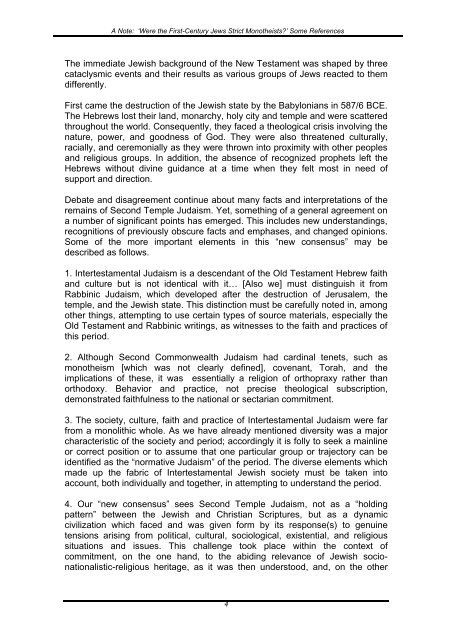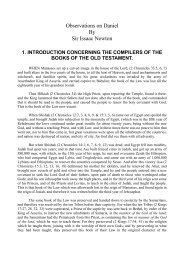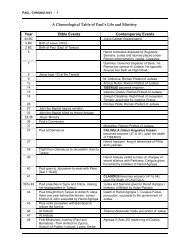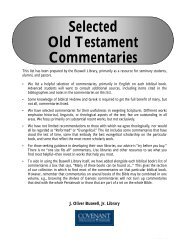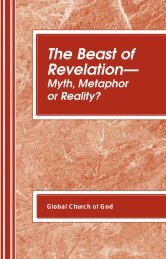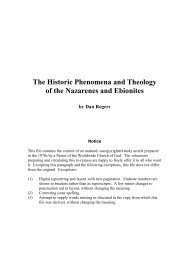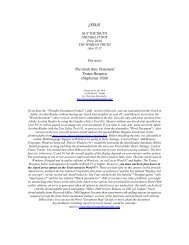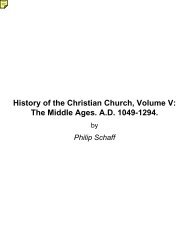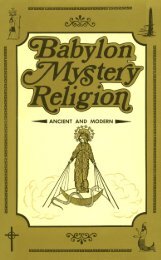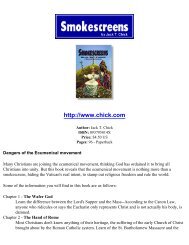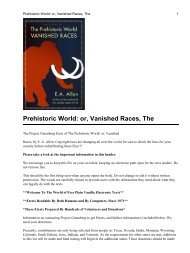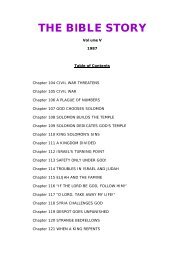Jews and Binitarianism.pdf - Friends of the Sabbath Australia
Jews and Binitarianism.pdf - Friends of the Sabbath Australia
Jews and Binitarianism.pdf - Friends of the Sabbath Australia
You also want an ePaper? Increase the reach of your titles
YUMPU automatically turns print PDFs into web optimized ePapers that Google loves.
A Note: ‘Were <strong>the</strong> First-Century <strong>Jews</strong> Strict Mono<strong>the</strong>ists?’ Some References<br />
The immediate Jewish background <strong>of</strong> <strong>the</strong> New Testament was shaped by three<br />
cataclysmic events <strong>and</strong> <strong>the</strong>ir results as various groups <strong>of</strong> <strong>Jews</strong> reacted to <strong>the</strong>m<br />
differently.<br />
First came <strong>the</strong> destruction <strong>of</strong> <strong>the</strong> Jewish state by <strong>the</strong> Babylonians in 587/6 BCE.<br />
The Hebrews lost <strong>the</strong>ir l<strong>and</strong>, monarchy, holy city <strong>and</strong> temple <strong>and</strong> were scattered<br />
throughout <strong>the</strong> world. Consequently, <strong>the</strong>y faced a <strong>the</strong>ological crisis involving <strong>the</strong><br />
nature, power, <strong>and</strong> goodness <strong>of</strong> God. They were also threatened culturally,<br />
racially, <strong>and</strong> ceremonially as <strong>the</strong>y were thrown into proximity with o<strong>the</strong>r peoples<br />
<strong>and</strong> religious groups. In addition, <strong>the</strong> absence <strong>of</strong> recognized prophets left <strong>the</strong><br />
Hebrews without divine guidance at a time when <strong>the</strong>y felt most in need <strong>of</strong><br />
support <strong>and</strong> direction.<br />
Debate <strong>and</strong> disagreement continue about many facts <strong>and</strong> interpretations <strong>of</strong> <strong>the</strong><br />
remains <strong>of</strong> Second Temple Judaism. Yet, something <strong>of</strong> a general agreement on<br />
a number <strong>of</strong> significant points has emerged. This includes new underst<strong>and</strong>ings,<br />
recognitions <strong>of</strong> previously obscure facts <strong>and</strong> emphases, <strong>and</strong> changed opinions.<br />
Some <strong>of</strong> <strong>the</strong> more important elements in this “new consensus” may be<br />
described as follows.<br />
1. Intertestamental Judaism is a descendant <strong>of</strong> <strong>the</strong> Old Testament Hebrew faith<br />
<strong>and</strong> culture but is not identical with it… [Also we] must distinguish it from<br />
Rabbinic Judaism, which developed after <strong>the</strong> destruction <strong>of</strong> Jerusalem, <strong>the</strong><br />
temple, <strong>and</strong> <strong>the</strong> Jewish state. This distinction must be carefully noted in, among<br />
o<strong>the</strong>r things, attempting to use certain types <strong>of</strong> source materials, especially <strong>the</strong><br />
Old Testament <strong>and</strong> Rabbinic writings, as witnesses to <strong>the</strong> faith <strong>and</strong> practices <strong>of</strong><br />
this period.<br />
2. Although Second Commonwealth Judaism had cardinal tenets, such as<br />
mono<strong>the</strong>ism [which was not clearly defined], covenant, Torah, <strong>and</strong> <strong>the</strong><br />
implications <strong>of</strong> <strong>the</strong>se, it was essentially a religion <strong>of</strong> orthopraxy ra<strong>the</strong>r than<br />
orthodoxy. Behavior <strong>and</strong> practice, not precise <strong>the</strong>ological subscription,<br />
demonstrated faithfulness to <strong>the</strong> national or sectarian commitment.<br />
3. The society, culture, faith <strong>and</strong> practice <strong>of</strong> Intertestamental Judaism were far<br />
from a monolithic whole. As we have already mentioned diversity was a major<br />
characteristic <strong>of</strong> <strong>the</strong> society <strong>and</strong> period; accordingly it is folly to seek a mainline<br />
or correct position or to assume that one particular group or trajectory can be<br />
identified as <strong>the</strong> “normative Judaism” <strong>of</strong> <strong>the</strong> period. The diverse elements which<br />
made up <strong>the</strong> fabric <strong>of</strong> Intertestamental Jewish society must be taken into<br />
account, both individually <strong>and</strong> toge<strong>the</strong>r, in attempting to underst<strong>and</strong> <strong>the</strong> period.<br />
4. Our “new consensus” sees Second Temple Judaism, not as a “holding<br />
pattern” between <strong>the</strong> Jewish <strong>and</strong> Christian Scriptures, but as a dynamic<br />
civilization which faced <strong>and</strong> was given form by its response(s) to genuine<br />
tensions arising from political, cultural, sociological, existential, <strong>and</strong> religious<br />
situations <strong>and</strong> issues. This challenge took place within <strong>the</strong> context <strong>of</strong><br />
commitment, on <strong>the</strong> one h<strong>and</strong>, to <strong>the</strong> abiding relevance <strong>of</strong> Jewish socionationalistic-religious<br />
heritage, as it was <strong>the</strong>n understood, <strong>and</strong>, on <strong>the</strong> o<strong>the</strong>r<br />
4


